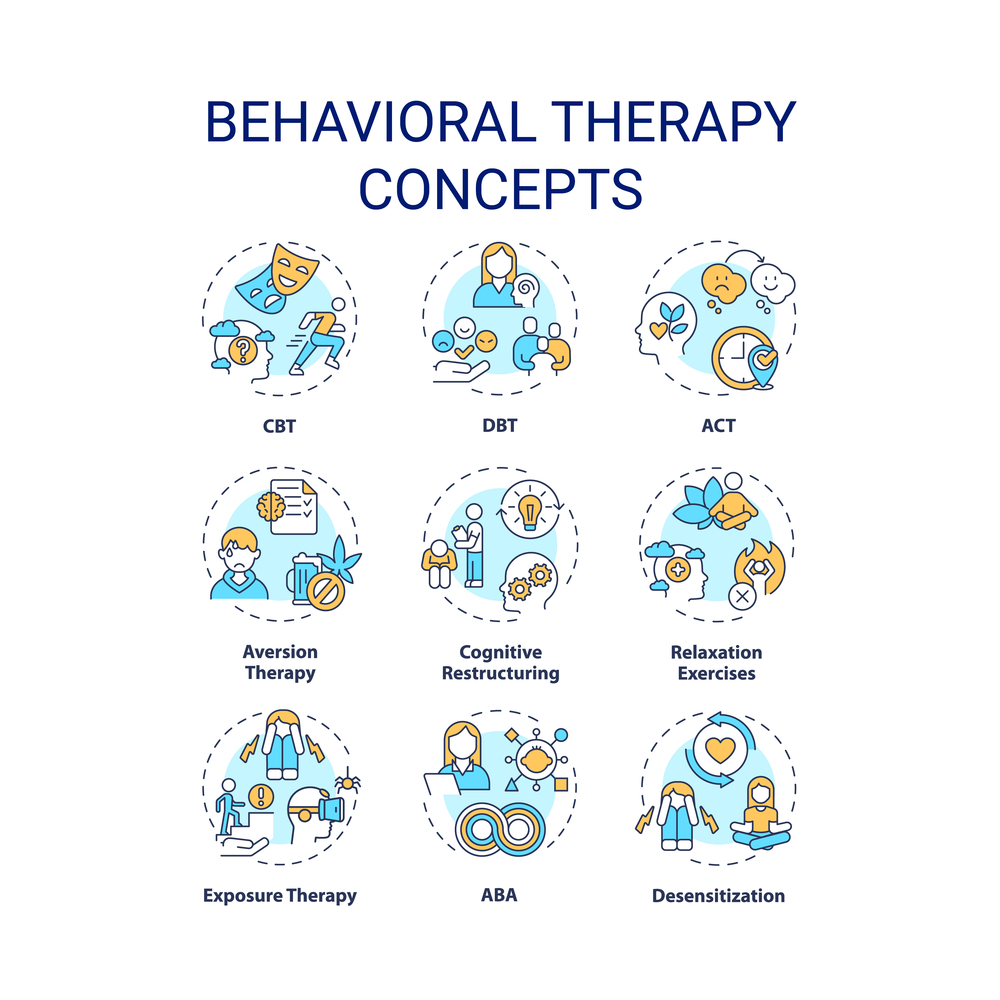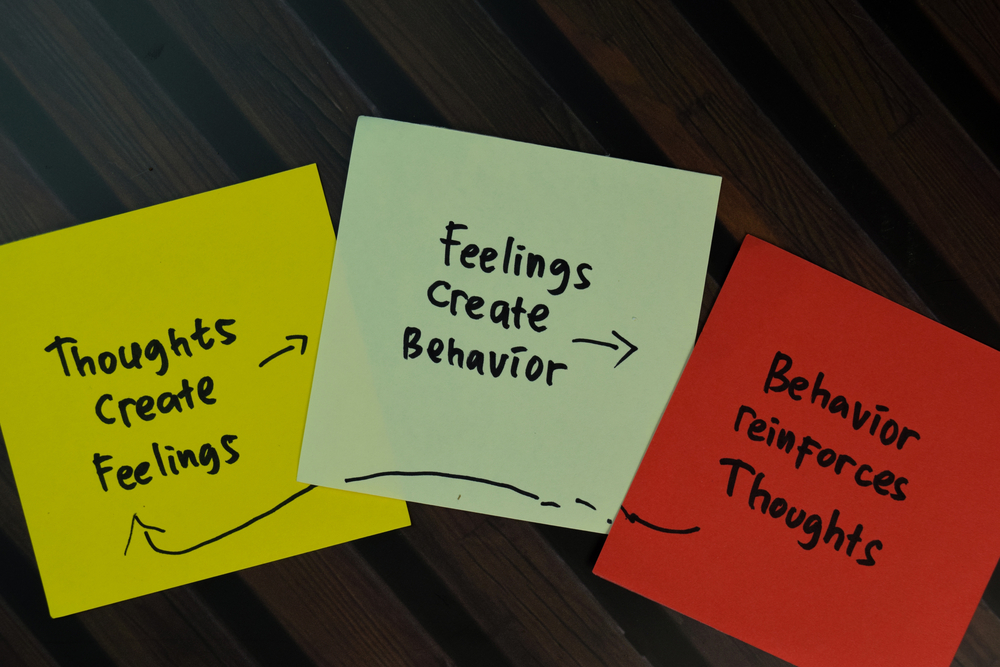Understanding the concept of therapy and its importance in mental health
Lesson 3

Spotlight on treatment types and their importance in mental health
Therapy is a collaborative process between a therapist and a client that aims to address mental health concerns, improve emotional well-being, and promote personal growth. It is a form of treatment that involves talking with a trained professional to explore and understand thoughts, feelings, and behaviours to develop coping strategies and make positive changes in one's life.
Therapy is vital in mental health for several reasons:
- Emotional support: Therapy provides a safe and supportive space where individuals can express their feelings and emotions without judgment. This support can be beneficial during challenging times or when dealing with difficult emotions such as sadness, anxiety, or anger.
- Identifying and managing mental health conditions: Therapy can help individuals recognise and diagnose mental health conditions. Working with a therapist, people can better understand their symptoms and learn strategies to manage their condition more effectively.
- Developing coping skills: Therapy equips individuals with various coping mechanisms and skills to navigate life's challenges. This may involve learning effective communication strategies, stress reduction techniques, or problem-solving skills to improve overall well-being.
- Enhancing self-awareness: Therapy promotes self-reflection and self-awareness, allowing individuals to understand themselves better. By exploring their thoughts, beliefs, and behaviour patterns, individuals can gain insight, develop self-compassion, and make positive changes.
- Improving relationships: Therapy can improve communication and interpersonal skills, leading to healthier relationships with family, friends, romantic partners, and colleagues. It can help individuals address relationship problems, set boundaries, and develop healthy ways of relating to others.
- Preventing relapse: For individuals with mental health conditions, therapy can play a crucial role in preventing relapse and maintaining stability. It provides ongoing support, helps individuals recognise early warning signs, and provides strategies to manage symptoms effectively.
It's important to note that therapy is not a one-size-fits-all approach; different therapeutic modalities may work better for others. The decision to seek therapy and the choice of a therapist should be based on individual needs, preferences, and the specific mental health concerns involved.
Various types of therapies can address individuals' behavioural and emotional problems, considering their different personality traits.
Here are some examples:
- Cognitive Behavioral Therapy (CBT): CBT is a widely used approach that identifies and changes negative thought patterns and behaviours. It can be effective for individuals with different personality traits by helping them challenge and reframe unhelpful thoughts, develop healthy coping strategies, and modify maladaptive behaviours.
- Dialectical Behavior Therapy (DBT): DBT is often used to treat individuals with borderline personality disorder or difficulty regulating emotions. It combines elements of CBT, mindfulness, and acceptance techniques. DBT helps individuals with emotional dysregulation improve emotional management, distress tolerance, interpersonal effectiveness, and mindfulness skills.
- Acceptance and Commitment Therapy (ACT): ACT is a mindfulness-based therapy that encourages individuals to accept their thoughts and emotions while taking committed action towards personal values. It can be beneficial for individuals struggling with emotional challenges and those who may exhibit avoidance or rigid behavioural patterns.
- Psychodynamic Therapy: Psychodynamic therapy explores unconscious processes that influence behaviour and emotions. It can be suitable for individuals with deep-seated personality traits and unresolved conflicts. The therapist helps individuals gain insight into their thoughts, feelings, and past experiences to promote personal growth and change.
- Schema Therapy: Schema therapy often addresses long-standing behavioural and emotional patterns stemming from early life experiences. It helps individuals identify and change maladaptive schemas (core beliefs) influencing their thoughts, emotions, and behaviours. Schema therapy can be beneficial for individuals with personality disorders or complex psychological challenges.
- Solution-Focused Brief Therapy (SFBT): SFBT focuses on identifying and building solutions rather than dwelling on problems. It is a time-limited approach that aims to help individuals set goals, recognise their strengths, and take small steps towards positive change. SFBT can be helpful for individuals who prefer a solution-oriented approach and are looking for practical strategies to address specific issues.
It's important to remember that the choice of therapy should be based on an individual's specific needs, preferences, and the therapist's expertise. Different therapy approaches can be adapted to suit different personality traits and effectively address a wide range of behavioural and emotional challenges.
Several established therapeutic approaches have demonstrated effectiveness in addressing mental health concerns.
Here are some widely recognised processes and their benefits:
- Cognitive Behavioral Therapy (CBT) focuses on the connection between thoughts, feelings, and behaviours. It helps individuals identify and change negative thought patterns and develop healthier coping strategies. CBT is effective for a range of mental health conditions, including depression, anxiety disorders, and substance abuse.
- Acceptance and Commitment Therapy (ACT): ACT emphasises accepting complex emotions and thoughts while committing to actions aligned with personal values. It teaches mindfulness skills and helps individuals develop psychological flexibility. ACT has shown effectiveness in treating conditions such as anxiety, depression, OCD, and chronic pain.
- Dialectical Behavior Therapy (DBT): DBT is commonly used to treat individuals with borderline personality disorder and difficulties regulating emotions. It focuses on developing skills in four areas: mindfulness, distress tolerance, emotion regulation, and interpersonal effectiveness. DBT helps individuals enhance emotion regulation, reduce self-destructive behaviours, and improve relationships.
- Psychodynamic Therapy: Psychodynamic therapy explores the unconscious processes that influence thoughts, emotions, and behaviours. It focuses on uncovering unresolved conflicts and working through them. Psychodynamic therapy can help individuals with a range of mental health concerns, including trauma, personality disorders, and relationship difficulties.
- Mindfulness-Based Stress Reduction (MBSR): MBSR incorporates mindfulness meditation, body awareness, and mindful movement to reduce stress and promote well-being. It is effective in managing chronic pain, anxiety, and depression.
- Schema Therapy: Schema therapy targets long-standing, deeply ingrained patterns of thoughts, feelings, and behaviours. It aims to identify and change maladaptive schemas or core beliefs. Schema therapy is effective for conditions such as personality disorders and chronic depression.
- Eye Movement Desensitization and Reprocessing (EMDR): EMDR is commonly used to address trauma-related disorders. It utilises bilateral stimulation (e.g., eye movements, tapping) while processing traumatic memories. EMDR has demonstrated effectiveness in treating post-traumatic stress disorder (PTSD) and other trauma-related conditions.
These are just a few examples of established therapeutic approaches. Each approach has its own unique techniques and benefits, and the choice of therapy depends on individual factors, specific mental health concerns, and the preferences of the individual seeking treatment. It's essential to consult a qualified mental health professional to determine the most appropriate therapeutic approach for one's needs.

Embracing Change: The Power of Acceptance and Commitment Therapy (ACT)
Acceptance and Commitment Therapy (ACT) is a form of psychotherapy that focuses on helping individuals accept their thoughts and feelings rather than trying to eliminate or control them. It encourages individuals to commit to actions that align with their values, promoting psychological flexibility and overall well-being.
Change is an inevitable and constant part of our lives. From the shifting seasons to personal transformations, it is crucial to acknowledge and embrace change to lead fulfilling and meaningful lives. However, navigating through the labyrinth of life's uncertainties can often be challenging. That is where Acceptance and Commitment Therapy (ACT) comes to the rescue.
The transformative power of ACT, uncovering its ability to help individuals accept change with compassion and commit to actions that align with their deepest values. Prepare yourselves for a journey towards embracing change like never before as we delve into the profound impact of Acceptance and Commitment Therapy.
The Foundation of Acceptance and Commitment Therapy: Understanding the Principles and Techniques
Acceptance and Commitment Therapy (ACT) is a powerful approach that helps individuals embrace change and overcome challenges. By understanding the principles and techniques behind ACT, individuals can cultivate acceptance, build psychological flexibility, and enhance their overall well-being.
Core Principles of ACT:
- Acceptance: ACT encourages individuals to embrace their thoughts and feelings without judgment or avoidance. It teaches that resistance to uncomfortable emotions only amplifies suffering, while approval enables personal growth and resilience.
- Mindfulness: Central to ACT is the practice of mindfulness, which involves paying attention to the present moment non-judgmentally and with openness. By developing mindfulness skills, individuals can anchor themselves in the present, reducing the impact of negative thoughts and emotions.
Techniques of ACT:
- Defusion: This technique helps individuals distance themselves from their thoughts, observing them rather than becoming entangled in them. By recognising that beliefs are false, individuals can lessen their power and create room for more helpful thoughts and actions.
- Values Clarification: ACT emphasises identifying and clarifying personal values, allowing individuals to live in alignment with what truly matters to them. By understanding their values, individuals can make choices that lead to a more fulfilling and meaningful life.
- Committed Action: In the ACT, individuals are encouraged to take committed action towards their values, even when faced with discomfort or challenges. This involves setting goals and taking small steps each day, fostering personal growth and resilience.
By embracing Acceptance and Commitment Therapy principles and techniques, individuals can develop the necessary skills to navigate change, cultivate acceptance, and lead a more fulfilling life. ACT empowers individuals to take charge of their well-being and live authentically, even in adversity.
Overcoming Anxiety and Stress with Acceptance and Commitment Therapy
Acceptance and Commitment Therapy, or ACT, is a powerful tool for managing anxiety and stress. By embracing change, individuals can develop valuable skills to cope with life's challenges. With ACT, individuals are encouraged to accept their thoughts and feelings instead of trying to control or avoid them.
This creates a sense of empowerment and allows individuals to focus on acting towards their values and goals.
In practising ACT, individuals learn to identify their core values and develop a clear sense of what is truly important to them. This helps to create a sense of purpose and direction in their lives, which can be particularly helpful in times of change. By aligning their actions with their values, individuals can make decisions and take steps consistent with who they want to be, even in the face of anxiety or stress.
The Role of Mindfulness in ACT
Mindfulness is a key component of Acceptance and Commitment Therapy, helping individuals cultivate awareness and non-judgmental acceptance of their thoughts and emotions. By practising mindfulness, individuals can learn to observe their anxious or stressful thoughts without getting caught up in them or trying to push them away. This allows for a greater sense of calm and control in the face of uncertainty and change.
The Power of Acceptance and Commitment Therapy
Acceptance is the first step towards finding relief from depression. It involves recognising and accepting negative thoughts and emotions without judgment or resistance. ACT teaches individuals to view their beliefs as passing events rather than absolute truths. This perspective allows individuals to create distance from their thoughts and emotions and to observe them with curiosity and compassion.
The Commitment to Change
Commitment is the second vital component of Acceptance and Commitment Therapy. It involves making a conscious decision to take action towards building a meaningful life despite the presence of negative thoughts and emotions.
This commitment pushes individuals to set goals aligned with their values and to take deliberate steps towards achieving them.
By committing to change, individuals gain a sense of purpose and direction in their lives, allowing them to navigate their depression and embrace a life of fulfilment and contentment.
The Power of Values in Acceptance and Commitment Therapy

Acceptance and Commitment Therapy (ACT) helps individuals embrace change by aligning their actions with their values.
By identifying and clarifying their values, individuals can gain insight into what truly matters to them and use that knowledge to guide their behaviour.
ACT encourages individuals to live by their values, even in the face of challenging thoughts and emotions.
Values serve as a compass, guiding individuals towards meaningful actions and a fulfilling life. Individuals may feel stuck or unsatisfied when connected to their values. Through ACT, individuals are encouraged to identify their core values and act in ways that align with them rather than being led by momentary thoughts and emotions.
This allows individuals to make choices that align with what truly matters to them, even when faced with challenges.
- Individuals can experience a sense of purpose and fulfilment by aligning actions with values.
- ACT teaches individuals to choose based on their values rather than avoiding discomfort or seeking short-term gratification.
- Through ACT, individuals develop the skills to accept and tolerate problematic thoughts and emotions while still taking action in line with their values.
Acceptance and Commitment Therapy Workbook: Practical Exercises for Embracing Change

Practical Exercises for Embracing Change
- Mindfulness Meditation:
Sit in a quiet space and focus on your breath, observing the sensations as you inhale and exhale. Notice any thoughts or feelings that arise without judgment or attachment.
Accept them as they are and let them pass. Practice this daily to cultivate mindfulness and develop a sense of clarity and peace.
1. Values Clarification:
Reflect on what truly matters to you in life. What are your core values? Write them down and prioritise them. Consider whether your current actions align with these values. Making choices that align with your values can bring a sense of purpose and fulfilment.
2. Defusion Techniques:
Recognise and detach from unhelpful thoughts and beliefs that hinder your progress. Label them as "just thoughts" or "simply memories" to create some distance and reduce their power. Understand that thoughts are not facts, and you can respond to them in a way that promotes acceptance and growth.
3. Committed Action:
Take small, manageable steps towards the changes you want to make. Create goals and commit to consistent action. Break them down into smaller tasks and celebrate each milestone achieved. Embrace the discomfort that comes with change, knowing it is a natural part of growth and self-improvement.
4. Self-Compassion:
Be kind to yourself throughout this journey of change. Treat yourself with the same compassion and understanding you offer a close friend. Remember that setbacks are an inevitable part of the process. Practice self-care and allow yourself to take breaks and seek support when needed.
Navigating Life's Uncertainties: Applying Acceptance and Commitment Therapy Techniques for Personal Transformation

Embracing Life's Uncertainties
Uncertainties are an inevitable part of life that often leave us feeling overwhelmed and anxious. Acceptance and Commitment Therapy (ACT) offers practical techniques to navigate these uncertainties and find personal transformation.
Accepting What We Cannot Control
ACT teaches us to accept the things we cannot control and focus on what is within our grasp. By acknowledging that uncertainty is a natural part of life, we can free ourselves from the constant need for certainty. This acceptance lets us let go of the stress and worry accompanying trying to control every aspect of our lives.
"The present moment is filled with joy and happiness. If you are attentive, you will see it."
― "Thich Nhat Hanh " ------
Building Resilience and Commitment

We learn to develop resilience with Acceptance and Commitment Therapy techniques in the face of uncertainties. We build skills to stay present and grounded, even when life throws unexpected challenges. By committing to our core values and aligning with them, we create a sense of purpose and meaning that empowers us to navigate life's uncertainties confidently and resiliently.
In summary
Acceptance and Commitment Therapy offers valuable tools to embrace life's uncertainties. By accepting what is beyond our control and focusing on our values, we can find personal transformation and navigate life with resilience and purpose. So, let go of the need for certainty and embrace the power of Acceptance and Commitment Therapy (ACT).
Uncovering the Power of Schema Therapy: A Professional Guide to Effective Psychological Treatment
Schema Therapy and Acceptance and Commitment Therapy (ACT) are both approaches used in mental health treatment, but they have distinct differences in their underlying principles and techniques.
Schema Therapy:
Schema Therapy is a form of psychotherapy that focuses on identifying and addressing maladaptive patterns or schemas that develop during childhood and influence an individual's thoughts, feelings, and behaviors in adulthood. These schemas are deeply ingrained and can contribute to various mental health issues, such as chronic depression, anxiety disorders, personality disorders, and relationship difficulties.
Key concepts and techniques in Schema Therapy include:
1. Early Maladaptive Schemas: These are core beliefs and patterns of thinking and behavior that develop in response to unmet emotional needs during childhood. Schema therapists work to identify and modify these maladaptive schemas.
2. Limited Reparenting: Schema therapists provide corrective emotional experiences by meeting the unmet emotional needs of their clients. This approach involves empathy, validation, and guidance in order to heal emotional wounds.
3. Mode Work: Schema Therapy incorporates the concept of "modes," which are different aspects of an individual's personality that may engage in particular thoughts, feelings, and behaviors in response to different situations. Therapy aims to help clients understand and manage their different modes more effectively.
Acceptance and Commitment Therapy (ACT):
Acceptance and Commitment Therapy is a mindfulness-based approach that encourages individuals to embrace their thoughts and feelings rather than trying to eliminate or control them. ACT focuses on developing psychological flexibility, which involves engaging in values-based actions guided by one's core values, rather than being driven by avoidance or emotional discomfort.
Key concepts and techniques in ACT include:
1. Acceptance: Rather than attempting to change or control unwanted thoughts and feelings, ACT encourages individuals to accept them as normal and natural experiences.
2. Cognitive Defusion: ACT aims to help individuals recognize that thoughts are not facts. Through various techniques, like metaphor and mindfulness exercises, cognitive defusion helps individuals create space between themselves and their thoughts.
3. Values Clarification: ACT emphasizes the importance of identifying and clarifying one's core values and using them as a guide for setting goals and taking action in alignment with those values.
In summary, Schemas or patterns consist of negative/dysfunctional thoughts and feelings which develop early in life as a result of the need for connection, autonomy, play and spontaneity, limits and assertion not being adequately met.
Schema Therapy focuses on understanding and modifying deeply ingrained maladaptive patterns, while ACT focuses on accepting and embracing thoughts and feelings and engaging in values-based actions.
Both approaches have their own unique techniques and may be beneficial in different situations, depending on the individual's needs and goals.
Schema Therapy is a groundbreaking approach in the field of psychology that offers a unique and highly effective way to treat psychological disorders. With its comprehensive understanding of long-standing patterns and ingrained beliefs, schema therapy provides professionals with powerful tools to help clients break free from negative cycles and develop healthier ways of thinking, feeling, and behaving.
Schema Therapy is a comprehensive therapeutic approach that integrates elements of cognitive-behavioral therapy (CBT), psychodynamic therapy, and attachment theory. It was developed by psychologist Dr. Jeffrey Young to address longstanding patterns of emotional and behavioral difficulties known as "schemas."
Whether you are a mental health professional seeking new treatment options or simply curious about the potential of schema therapy for personal growth, this guide aims to provide valuable insights into this transformative therapeutic modality. Schema Therapy recognises all aspects of neurophysiology in its approach. Neuroscience teaches us that we each have an inbuilt capacity for growth and healing (Siegel, Daniel J., 2011).
Understanding the Core Principles of Schema Therapy
Schema therapy is a powerful approach to psychological treatment that aims to address deep-seated, negative patterns or beliefs developed during childhood. These patterns are "schemas" and can significantly impact an individual's thoughts, emotions, and behaviours.
In schema therapy, therapists work collaboratively with their clients to identify and understand these schemas through traditional talk therapy techniques and experiential exercises. The goal is to unearth the underlying core needs not met in childhood and develop healthier coping strategies.
By focusing on past experiences and current behaviours, schema therapy provides a comprehensive understanding of an individual's struggles to create lasting change. Therapists utilise techniques such as imagery rescripting, chair work, role play, and cognitive restructuring to help their clients challenge their maladaptive schemas and replace them with more adaptive ones.
Through this process of self-discovery and transformation, individuals can break free from harmful patterns that have held them back for years. Schema therapy offers hope for those who may have tried other forms of treatment without success by addressing the root causes of emotional distress head-on.
Practical Techniques in Schema Therapy for Mental Health
Techniques to Enhance Schema Therapy's Effectiveness in Mental Health Treatment
Schema therapy offers a range of practical techniques that can be used to address and transform maladaptive schemas. Some key strategies include:
Cognitive Restructuring:
- This technique helps individuals challenge and change negative thoughts by identifying the underlying core beliefs associated with their maladaptive schema. By examining the evidence for and against these beliefs, clients can develop more adaptive ways of thinking.
Imagery Rescripting:
- This powerful method involves revisiting painful memories or traumatic events related to the client's schema and replacing them with new, positive images or scenarios that contradict the negative self-schema. Through visualisation exercises, individuals can rewrite their narratives and cultivate alternative perspectives.
Emotion-Focused Techniques:
- The recognition and processing of emotions play a crucial role in schema therapy. Therapists often employ experiential techniques like chair work or guided imagery to help clients explore and express suppressed emotions linked to their schemas, facilitating emotional healing and growth.
By incorporating these techniques into treatment plans, mental health professionals can maximise the effectiveness of schema therapy interventions while empowering individuals to challenge unhealthy patterns of thinking, feeling, and behaving.
Schema Therapy for Personality Disorders: A Comprehensive Approach
Schema therapy is a highly effective treatment approach for individuals with personality disorders. It focuses on identifying and addressing maladaptive patterns or schemas developed during childhood. By exploring these deeply ingrained beliefs, schema therapy helps clients gain insight into how their past experiences shape their current thoughts, feelings, and behaviours.
- Identifying Schemas: In the first phase of treatment, therapists work collaboratively with clients to identify specific schemas that contribute to their personality disorder symptoms. Standard schemas include abandonment, mistrust/abuse, emotional deprivation, defectiveness/shame, social isolation/exclusion, and failure.
- Understanding Modes: Another key aspect of schema therapy involves understanding different modes or coping mechanisms individuals use when triggered by specific situations or events. These modes can range from vulnerable child to angry parent mode and are often linked to specific schemas.
- Changing Maladaptive Coping Strategies: Once identified and understood, therapists help clients challenge their maladaptive coping strategies associated with different modes through cognitive restructuring techniques such as imagery rescripting and limited reparenting exercises to meet unmet needs within a therapeutic relationship setting.
Rather than focusing solely on symptom reduction like other therapies do towards personality disorders, Schemtaic Therapy takes a comprehensive approach by targeting the underlying core beliefs contributing to the disorder's manifestation. With its emphasis on fostering change at both cognitive-emotional levels coupled with implementing healthy behavioural alternatives, schema therapy offers a practical framework for long-term healing in individuals struggling with personality disorders.
Its integration of techniques borrowed from various psychotherapeutic approaches provides an adaptable toolset accommodating unique client needs during sessions while still adhering closely to its theoretical foundations. This makes it an ideal choice for mental health professionals looking for impactful interventions in working therapeutically, not just quick fixes but lasting well-being improvements.
Comparing Schema Therapy with Other Therapies: Advantages and Considerations
When comparing schema therapy to other therapies, several advantages are worth mentioning. First, unlike traditional cognitive-behavioural therapy (CBT), which focuses primarily on symptom reduction, schema therapy addresses the underlying schemas or core beliefs that drive maladaptive behaviours. This holistic approach allows for more comprehensive and long-lasting change.
Additionally, compared to psychodynamic therapy, schema therapy provides a more structured and time-limited treatment plan. By incorporating techniques from CBT within a psychodynamic framework, clients can benefit from insight-oriented exploration and practical strategies for managing their symptoms effectively.
While schema therapy has many advantages, it's essential to consider some potential limitations. For instance, due to its intensive nature and focus on deep-rooted patterns of thinking and behaviour, this type of treatment may require a longer duration than other therapeutic approaches.
Moreover, because it delves into unresolved childhood experiences that contribute to schemas developmentally engrained in individuals' minds over time, it may not be suitable for all clients or address acute issues requiring immediate intervention.
To make an informed decision about whether schema therapy is suitable for you or your client - assessing personal goals together with DSM-5 diagnoses becomes crucial since different psychological treatments have unique strengths tailored towards specific concerns.
List of Schemas:
- Emotional Deprivation: The belief and expectation that your primary needs will never be met. The sense that no one will nurture, care for, guide, protect or empathise with you.
- Abandonment: The belief and expectation that others will leave, that others are unreliable, that relationships are fragile, that loss is inevitable and that you will ultimately end up alone.
- Mistrust/Abuse: The belief that others are abusive, manipulative, selfish, or looking to hurt or use you and are not to be trusted.
- Defectiveness: The belief that you are flawed, damaged or unlovable and you will therefore be rejected.
- Social Isolation: The pervasive sense of aloneness, coupled with a feeling of alienation.
- Vulnerability: The sense that the world is a dangerous place, that disaster can happen at any time and that you will be overwhelmed by the challenges that lie ahead.
- Dependence/Incompetence: The belief that you are unable to make your own decisions, that your judgment is questionable, and that you need to rely on others to help get you through day-to-day responsibilities.
- Enmeshment/Undeveloped Self: The sense that you do not have an identity or “individuated self” that is separate from one or more significant others.
- Failure: The expectation that you will fail or the belief that you cannot perform well enough.
- Subjugation: The belief that you must submit to the control of others or else punishment or rejection will be forthcoming.
- Self-Sacrifice: The belief that you should voluntarily give up your own needs for the sake of others, usually to a point which is excessive.
- Approval-Seeking/Recognition-Seeking: The sense that approval, attention and recognition are far more important than genuine self-expression and being true to oneself.
- Emotional Inhibition: The belief that you must control your self-expression or others will reject or criticise you.
- Negativity/Pessimism: The pervasive belief that the negative aspects of life outweigh the positive, along with negative expectations for the future.
- Unrelenting Standards: The belief that you need to be the best, always striving for perfection or that you must avoid mistakes.
- Punitiveness: The belief that people should be harshly punished for their mistakes or shortcomings.
- Entitlement/Grandiosity: The sense that you are special or more important than others, and that you do not have to follow the rules like other people even though it may have a negative effect on others. Also can manifest in an exaggerated focus on superiority for the purpose of having power or control.
- Insufficient Self-Control/Self-Discipline: The sense that you cannot accomplish your goals, especially if the process contains boring, repetitive, or frustrating aspects. Also, that you cannot resist acting upon impulses that lead to detrimental results.
(https://www.schemainstitute.co.uk/understanding-schema-therapy/)
Schema Therapy Vs Morita Therapy in mental health
With schema Therapy, the therapist helps the individual understand their schemas and how they manifest in their thoughts, feelings, and behaviors. The therapy then aims to challenge and change these maladaptive schemas by providing new experiences and perspectives.
On the other hand, Morita Therapy is a type of therapy that originated in Japan and is primarily used for treating anxiety and other emotional disorders. It is based on the philosophy of acceptance, acknowledging and accepting the natural ebb and flow of emotions rather than trying to eliminate or control them.
Morita Therapy focuses on helping individuals understand and accept their emotions rather than attempting to change them. The therapy aims to support individuals in developing a more harmonious relationship with their emotions, allowing them to live a fulfilling life even in the presence of challenging emotions.In summary, while both Schema and Morita Therapy are approaches used in mental health treatment, they have different focuses and techniques.
Schema Therapy primarily identifies and changes negative patterns and beliefs, whereas Morita Therapy emphasises acceptance and developing a healthy relationship with emotions. The choice of therapy would depend on the individual's specific needs and preferences.
Unlocking the Power of Morita Therapy: A Professional Guide to Resilience and Emotional Well-being

Welcome to "Unlocking the Power of Morita Therapy: A Professional Guide to Resilience and Emotional Well-being." In this section, we will delve into the transformative world of Morita Therapy, a Japanese psychotherapeutic approach rooted in Zen Buddhist principles.
This therapeutic modality, developed by Dr. Shoma Morita in the early 20th century, has gained significant recognition for cultivating resilience and fostering emotional well-being.
We invite you on a journey through the core tenets of Morita Therapy as we explore its techniques, benefits, and practical applications in today's fast-paced and demanding world. Join us as we unlock the secrets behind enhancing mental health through embracing discomfort, cultivating mindfulness, and nurturing acceptance as key pillars of lasting emotional wellness - all underpinned by timeless wisdom passed down from generations past.
The Origins and Principles of Morita Therapy: Exploring the foundations and key concepts behind this transformative psychotherapeutic approach:
Morita Therapy, developed by Japanese psychiatrist Shoma Morita in the early 20th century, is a holistic and mindfulness-based therapeutic approach. It emphasises acceptance of one's emotional experiences rather than trying to suppress or control them. This therapy focuses on helping individuals develop resilience and emotional well-being through promoting self-acceptance and taking action despite their emotional state.
Key Principles:
- Acceptance: Morita Therapy believes that accepting all emotions, including fear, anxiety, and sadness, is crucial for personal growth. By taking these emotions as part of the human experience, individuals can move towards embracing their own uniqueness.
- Action-oriented approach: Instead of waiting for emotions to change before taking action, Morita Therapy encourages clients to take appropriate steps regardless of their emotional state. This emphasis on engaging with life helps individuals build resilience and a sense of purpose.
- Simplicity in daily activities: Morita Therapy promotes clarity in daily routines along with action-taking. By mindfully engaging in simple tasks without expectation or judgment, individuals learn to be fully present in each moment.
- Natural progression: A fundamental principle of Morita Therapy is recognising that emotions naturally evolve if they are accepted instead of resisted or suppressed. Trusting this natural progression allows individuals to gain insight into themselves while avoiding unnecessary suffering.
- Positive attitudes towards discomfort: Rather than viewing discomfort as something negative or abnormal that needs fixing immediately, Morita Therapy teaches individuals how to navigate discomfort with curiosity and openness – seeing it as an opportunity for growth rather than avoidable pain.
Incorporating these principles can empower individuals to cultivate resilience while enhancing emotional well-being throughout various life challenges.
Understanding the Role of Resilience in Morita Therapy: Discovering how Morita Therapy helps individuals develop resilience and overcome challenges
Developing Resilience with Morita Therapy
Resilience is a crucial trait that allows individuals to bounce back from adversity and thrive in the face of challenges. In Morita Therapy, resilience is central to helping individuals overcome their struggles and achieve emotional well-being. This therapeutic approach focuses on accepting difficult emotions as natural and encourages patients to develop resilience by learning how to navigate these emotions effectively.
Learning Acceptance Through Experience
Morita Therapy helps individuals understand that experiencing challenging emotions is not abnormal or something to be avoided. Instead, it emphasises acceptance of these feelings as a fundamental part of being human. By learning this acceptance, individuals can develop the resilience to face their emotions head-on and work towards self-improvement.
Embracing Impermanence for Emotional Growth
A key principle in Morita Therapy involves embracing impermanence – recognising that all things pass naturally with time. This mindset shift allows individuals to view failures, setbacks, or negative emotions as fleeting experiences rather than permanent aspects of their lives. By understanding the transient nature of emotions, patients can cultivate resilience by acknowledging that difficult times will eventually give way to more positive moments.
In summary, Morita Therapy promotes the development of resilience by teaching acceptance and embracing impermanence. This approach empowers individuals to confront their challenges directly without fear while fostering long-lasting emotional well-being.
Techniques and Practices in Morita Therapy: Exploring the various methods and practices used in Morita Therapy to promote emotional well-being
Techniques and Practices in Morita Therapy
Morita Therapy utilises various techniques and practices to help individuals enhance their emotional well-being.
These methods aim to promote acceptance, mindfulness, and action-oriented behaviour.
- Acceptance: The foundational principle of Morita Therapy is accepting one's emotions without judgment or resistance. Clients are encouraged to embrace their feelings as natural and valid responses to life circumstances. Individuals can better understand themselves and cultivate inner peace by acknowledging and accepting these emotions.
- Mindfulness: Mindfulness exercises play a crucial role in Morita Therapy. Through practices like meditation or focusing on the present moment, clients learn to observe their thoughts and feelings without getting caught up in them. This heightened awareness allows individuals to develop a more balanced perspective while reducing anxiety or excessive rumination.
- Action-Oriented Behavior: Morita Therapy emphasises taking meaningful action despite discomfort or fear rather than waiting for motivation or improved emotional states. Clients engage in "shugyo," which involves committing wholeheartedly to daily tasks regardless of their mood at the time – this promotes personal growth, self-discipline, resilience, and increased satisfaction with one's work.
By incorporating these techniques into daily life, individuals can strengthen their emotional well-being through self-acceptance, mindful awareness of the present moment, and productive action-taking behaviours that lead towards personal growth.
Applying Morita Therapy in Everyday Life: Examining how Morita Therapy can be integrated into daily routines to enhance resilience and emotional well-being
Applying Morita Therapy in Everyday Life
Developing a Daily Routine:
- Incorporate elements of Morita Therapy into your daily routine to enhance resilience and emotional well-being.
- Begin each day by setting goals and focusing on the present moment.
- Take small, incremental steps towards achieving these goals, allowing yourself to engage with the tasks at hand fully.
- Embrace discomfort and accept that it is natural to experience various emotions throughout the day.
Engaging in Purposeful Action: Engage in purposeful action by accepting responsibility for your own well-being and actively participating in activities that align with your values. Instead of getting lost in rumination or seeking immediate gratification, focus on completing meaningful tasks that contribute to your overall growth and happiness.
Embracing 'Shizen': Embrace the concept of 'shizen' or naturalness in Morita Therapy by accepting positive and negative emotions without judgment. Recognise that emotions are transient, flowing like waves, rather than something to be suppressed or avoided. You can develop greater acceptance and resilience by acknowledging all emotions as part of life's ebbs and flows.
Practical Strategies for Integrating Morita Therapy into Everyday Life
- Mindfulness Practice: Carve out time daily for mindfulness practice, such as meditation or deep breathing exercises. This allows you to cultivate awareness of the present moment while observing thoughts and feelings without attachment or judgment.
- Journaling: Regularly writing down thoughts, emotions, and experiences can help facilitate self-reflection and gain insight into patterns of behaviour or thought processes that may hinder emotional well-being.
- Physical Activities: Engaging in physical activities like walking outdoors or practising yoga promotes physical health and encourages mindful movement, fostering a deeper connection between body and mind.
- Setting Realistic Expectations: Avoid setting unrealistic expectations for yourself, as they can lead to frustration and feelings of inadequacy. Instead, set attainable goals and appreciate the progress made each day.
- Practicing Self-Compassion: Treat yourself with kindness and understanding during challenging moments. Cultivate self-compassion by offering comforting words or gestures to soothe yourself when faced with challenges or setbacks.
By integrating Morita Therapy into our everyday lives, we can unlock resilience and experience greater emotional well-being, ultimately leading to a more fulfilling life.
Case Studies: Real-Life Examples of Morita Therapy: Examining real-life case studies that highlight the effectiveness of Morita Therapy in improving emotional well-being
Morita Therapy Case Study 1: Overcoming Social Anxiety
Sarah, a 31-year-old marketing executive, sought Morita Therapy to address her debilitating social anxiety. Through the therapy sessions, Sarah gradually learned to accept her anxious thoughts and feelings without fighting or avoiding them. She discovered that by allowing herself to experience anxiety without judgment, she could detach from its grip and regain control over her life.
Over time, Sarah engaged in activities that triggered her social anxiety with support from her therapist. Initially, challenging tasks such as attending networking events became increasingly manageable for Sarah as she practised accepting discomfort instead of trying to eliminate it. She transformed her relationship with social situations by reframing fear as a normal part of the human experience rather than something inherently negative or dangerous. She experienced significant improvement in her emotional well-being.
Morita Therapy Case Study 2: Coping with Grief and Loss
Mark, a widower grieving the loss of his spouse of 40 years, turned to Morita Therapy for guidance during this challenging period. With his therapist's assistance, Mark began acknowledging and embracing his sorrowful emotions unreservedly. Rather than attempting to suppress or escape grief - which only prolonged the healing process - he learned through Morita Therapy how acceptance can facilitate growth.
As Mark consented himself time for mourning each day during designated "grieving periods," he noticed positive changes occurring within him naturally. Bringing mindfulness into his routine provided solace while restoring the balance between sadness and functionality. Moving forward amid grief gradually but indeed taught Mark valuable resilience skills anchored in authentic emotional processing – an indispensable asset on his journey towards rediscovering happiness.
The Benefits of Morita Therapy: Exploring the wide range of benefits individuals can experience through the practice of Morita Therapy
The Benefits of Morita Therapy
Morita Therapy offers many benefits for individuals seeking resilience and emotional well-being. Here are some key advantages that come with practising this therapeutic approach:
- Increased Self-Awareness: Through Morita Therapy, individuals can develop a deeper understanding of their thoughts, feelings, and behaviours. This heightened self-awareness allows them to identify patterns and triggers that may contribute to their emotional distress.
- Acceptance and Non-Judgment: Central to Morita Therapy is accepting one's experiences without judgment or resistance. Individuals can find relief from unnecessary suffering by learning to accept their emotions as natural phenomena rather than problems to be solved or eliminated.
- Improved Resilience: With Morita Therapy, individuals learn how to cope effectively with difficult emotions by embracing them as valuable information rather than trying to escape or suppress them. This fosters a sense of resilience, enabling individuals to navigate life's challenges more easily.
How Morita Therapy Works
Morita Therapy focuses on four stages designed for practical engagement in daily life:
- Resting Stage: During this stage, clients are encouraged to rest and resist engaging in any problem-solving or analysis regarding their current emotions or circumstances.
- Acceptance Stage: Clients shift towards acceptance by acknowledging their present reality without judgment or resistance.
- Natural Action Stage: In this stage, clients engage in activities consistent with what needs attention in daily life—regardless of how they may feel about it initially—and focus on taking small steps forward instead of waiting for motivation.
- Self-Reflection Stage: Finally, clients take time each day for self-reflection on their actions using techniques such as journaling or meditation.
Overall, these stages enable individuals who practice Morita Therapy to cultivate acceptance while moving forward constructively in daily life—a powerful combination that promotes resilience and emotional well-being.
Morita Therapy and Mindfulness: Understanding the connection between Morita Therapy and mindfulness practices and how they complement each other
Morita Therapy and Mindfulness: Understanding the Connection
Morita therapy and mindfulness practices are closely connected, focusing on accepting and embracing one's present-moment experience.
- Both approaches emphasise the importance of non-judgmental awareness of thoughts, emotions, and physical sensations. In Morita therapy, this is achieved through developing an attitude of acceptance towards one's symptoms rather than trying to eliminate them or label them as good or bad.
- Mindfulness practices help individuals cultivate this non-judgmental awareness by observing their thoughts without getting caught up in them or attaching meaning to them.
How They Complement Each Other
Morita therapy and mindfulness complement each other by offering different tools for managing emotions and building resilience:
- Acceptance: Morita therapy encourages patients to accept their current emotional state instead of trying to change it. This allows individuals to progress with daily activities despite feeling anxious or stressed. Mindfulness practices promote acceptance by teaching individuals to observe their feelings without judgment.
- Non-attachment: Both approaches teach individuals not to get too attached to their thoughts or emotions. By recognising that these experiences come and go naturally, individuals can prevent themselves from being overwhelmed by distressing emotions.
- Present-moment focus: Morita therapy aims to shift attention away from past regrets/future worries toward present actions/reality. This aligns with mindfulness practices' emphasis on anchoring oneself in the present moment through techniques such as deep breathing or body scans.
Incorporating elements from both Morita therapy and mindfulness can enhance emotional well-being while promoting resilience in challenging situations.
Integrating Morita Therapy into Professional Practice: Exploring how Morita Therapy can be incorporated into various professional settings, such as counselling, psychology, and coaching.
Integrating Morita Therapy into Professional Practice:
Morita Therapy, a Japanese psychological approach rooted in acceptance and action, can be integrated into various professional settings to enhance resilience and emotional well-being. In counselling, practitioners can incorporate Morita principles by fostering self-acceptance and encouraging clients to embrace their emotions rather than attempting to suppress or control them.
By acknowledging the impermanence of feelings and cultivating an attitude of non-judgmental observation, counsellors can help individuals develop healthier relationships with their emotions.
Incorporating Morita Therapy involves utilising its techniques alongside existing therapeutic approaches in psychology. For example, combining cognitive-behavioural therapy (CBT) or mindfulness-based interventions with Morita's emphasis on engaging in purposeful activities can provide clients with increased tools for managing anxiety or depression. This integration ensures a comprehensive approach that addresses both cognitions and behaviours while appreciating the importance of accepting internal experiences without judgment.
Coaching professionals can also benefit from integrating Morita principles into their practice. By emphasising personal growth through action-oriented goals and promoting mindful engagement in one's pursuits, coaches can help individuals cultivate resilience and emotional well-being. Incorporating Morita elements encourages clients to view setbacks as opportunities for learning rather than failure, enabling them to persevere towards more significant achievements.
Acceptance and Commitment Therapy (ACT), Cognitive behavioural therapy (CBT) and Dichotomy of control are similar.
Acceptance and Commitment Therapy (ACT) and Cognitive Behavioral Therapy (CBT) are both evidence-based psychotherapeutic approaches that aim to help individuals improve their mental health and well-being. While they share some similarities, they also have distinct differences.
Acceptance and Commitment Therapy (ACT) promotes psychological flexibility and acceptance of uncomfortable thoughts and emotions rather than trying to change or control them. It encourages individuals to identify their values and commit to living meaningfully despite difficult thoughts and feelings. ACT also emphasises the concept of mindfulness and being present in the current moment.
On the other hand, Cognitive behavioural therapy (CBT) primarily focuses on identifying and changing negative or maladaptive thought patterns and behaviours. It aims to challenge and replace irrational or distorted thoughts with more rational and realistic ones. Cognitive behavioural therapy also incorporates behavioural techniques to help individuals modify their actions and develop healthier coping mechanisms.
Both Acceptance and Commitment Therapy and Cognitive behavioural therapy are beneficial for a range of mental health conditions, including anxiety disorders, depression, and substance use disorders. They are typically structured and goal-oriented, involving regular sessions with a trained therapist.
The Dichotomy of Control, often associated with Stoic philosophy, distinguishes between things within our control and those outside our control. True happiness and peace of mind come from accepting and focusing on the things we control, such as our thoughts, attitudes, and actions, rather than being consumed by or trying to change external circumstances beyond our control.
While the Dichotomy of Control is not a therapeutic approach like ACT or CBT, it shares a similar philosophy regarding accepting what cannot be changed and focusing on what can be influenced. It encourages individuals to let go of excessive worry or attachment to outcomes beyond their control and rather prioritise their inner state and personal growth.
Overall,Acceptance and Commitment Therapy, Cognitive behavioural therapy (CBT), and the Dichotomy of Control all have their own unique approaches and techniques. Still, they share common themes of acceptance, mindfulness, and focusing on what can be changed or influenced for improved mental well-being.
